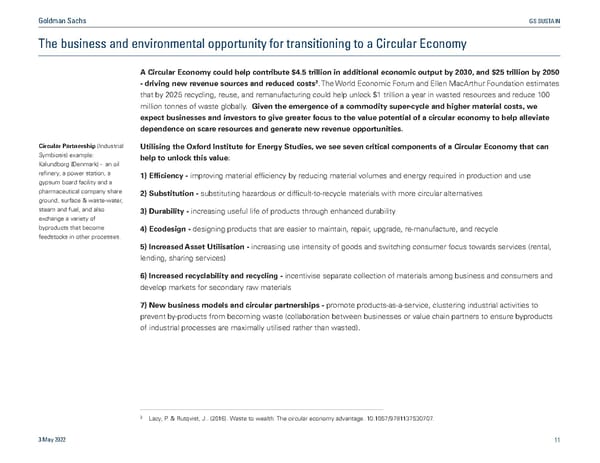Goldman Sachs GS SUSTAIN The business and environmental opportunity for transitioning to a Circular Economy A Circular Economy could help contribute $4.5 trillion in additional economic output by 2030, and $25 trillion by 2050 2 - driving new revenue sources and reduced costs . The World Economic Forum and Ellen MacArthur Foundation estimates that by 2025 recycling, reuse, and remanufacturing could help unlock $1 trillion a year in wasted resources and reduce 100 million tonnes of waste globally. Given the emergence of a commodity super-cycle and higher material costs, we expect businesses and investors to give greater focus to the value potential of a circular economy to help alleviate dependence on scare resources and generate new revenue opportunities. Circular Partnership (Industrial Utilising the Oxford Institute for Energy Studies, we see seven critical components of a Circular Economy that can Symbiosis) example: help to unlock this value: Kalundborg (Denmark) - an oil refinery, a power station, a 1) Efficiency - improving material efficiency by reducing material volumes and energy required in production and use gypsum board facility and a pharmaceutical company share 2) Substitution - substituting hazardous or difficult-to-recycle materials with more circular alternatives ground, surface & waste-water, steam and fuel, and also 3) Durability - increasing useful life of products through enhanced durability exchange a variety of byproducts that become 4) Ecodesign - designing products that are easier to maintain, repair, upgrade, re-manufacture, and recycle feedstocks in other processes. 5) Increased Asset Utilisation - increasing use intensity of goods and switching consumer focus towards services (rental, lending, sharing services) 6) Increased recyclability and recycling - incentivise separate collection of materials among business and consumers and develop markets for secondary raw materials 7) New business models and circular partnerships - promote products-as-a-service, clustering industrial activities to prevent by-products from becoming waste (collaboration between businesses or value chain partners to ensure byproducts of industrial processes are maximally utilised rather than wasted). 2 Lacy, P. & Rutqvist, J.. (2016). Waste to wealth: The circular economy advantage. 10.1057/9781137530707. 3 May 2022 <<
 GS SUSTAIN: Circular Economy Report Page 11 Page 13
GS SUSTAIN: Circular Economy Report Page 11 Page 13